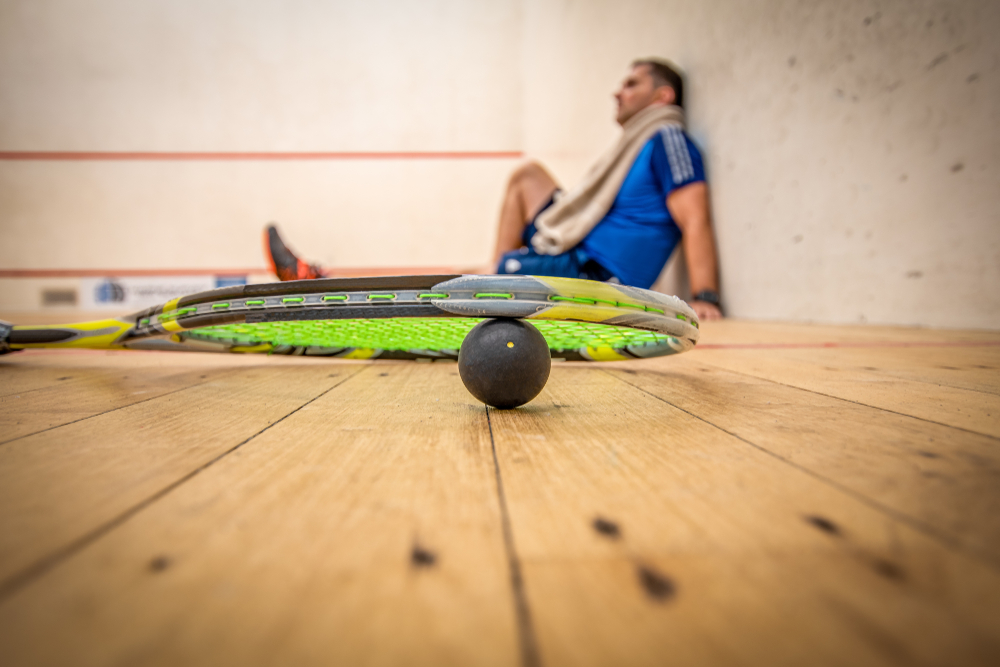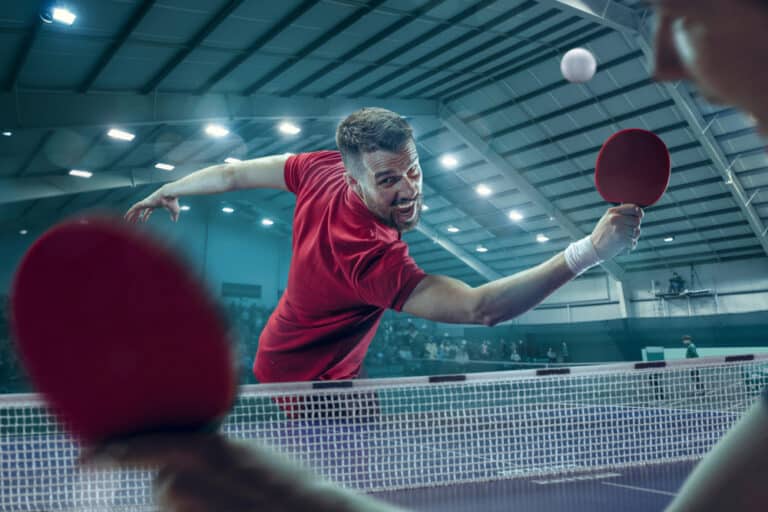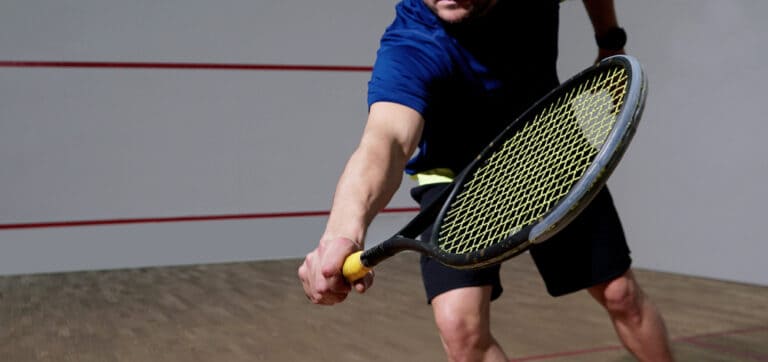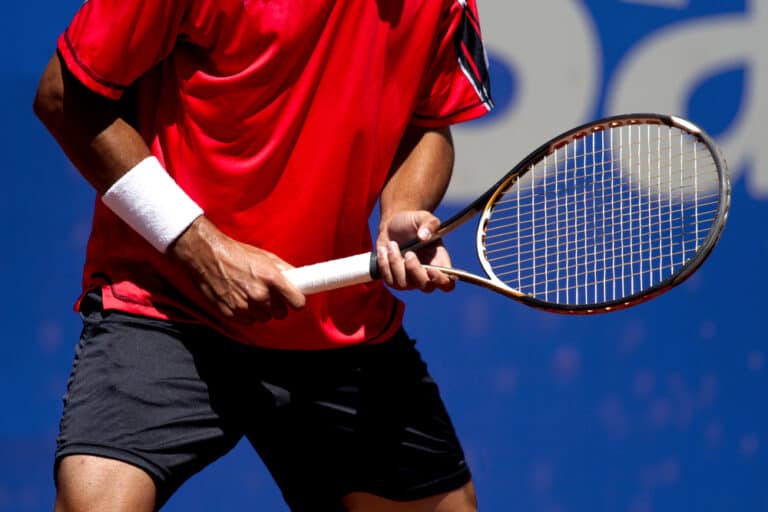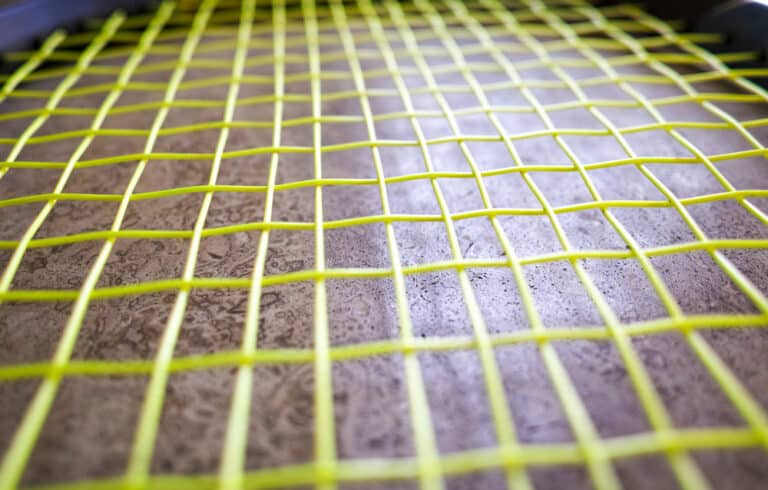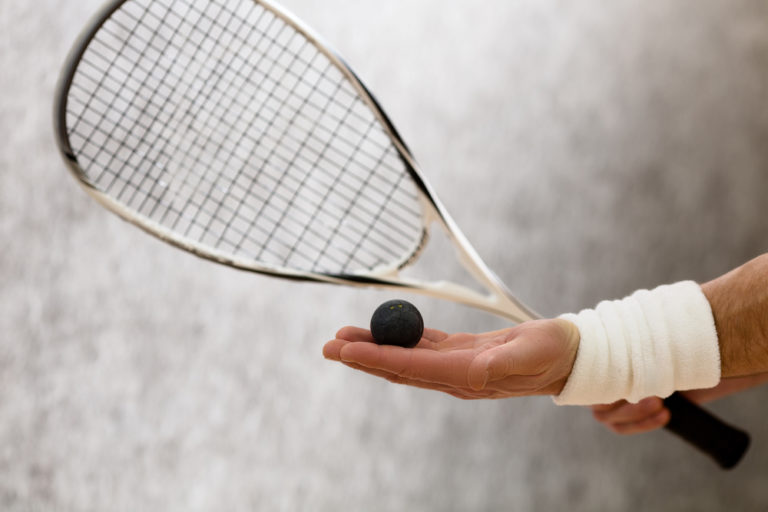What Is The Most Common Injury In Squash?
As racquet and court games go, squash is rated as one of the fastest, most strenuous, and most dangerous in terms, and as such, it results in a wide variety of injuries to players and damage to the equipment itself.
The most common injury in squash is lower back strains, leg muscle strains, tennis elbow, golf elbow, impact injuries bruising from getting hit with the ball or racquet, eye and facial bruising, colliding with the walls and the other player, as well as bruising caused by racquet kicking!
Let’s get on the court and take a first-hand look at this game, and how and why these common injuries occur so, you can better understand the injury risks of this fast-paced, fun but risky sport.
Are Squash Injuries Very Common
If you haven’t played the game before, you may think that squash injuries are prevalent, but in fact, injuries in squash as a sport represent a low percentage of overall sports injuries.
It is true that because of the game’s character, it lends itself to injuries, but no more than other impact sports like football do.
With any sport, you need to have a level of fitness and conditioning. While you may not be able to avoid getting hit with the ball occasionally, hitting the wall, or bumping into another player, as you get fitter, stronger and better conditioned to the game, the risk of severe or even light injury decreases.
Of course, hydration before and during the game plays a role, and this can prevent muscle cramps during play; proper nutrition will also assist with energy and recovery.
Muscle Strains Are The Most Common Injury In Squash
The nature of squash requires players to be both fit and flexible, as running during rallies and stretching to hit the ball are part and parcel of this game. Putting the body under this kind of duress will result in strains, tears, and pulls, and many of these affect the lower back.
Injuries like this often occur when players are not adequately warmed up and try to reach or stretch for a ball and end up straining the back.
The game’s pace lends itself to this kind of injury, and physios are chock-a-block with professional and amateur squash players seeking a remedy for these common squash injuries.
If you are going to play squash or are playing it already, it is imperative to stretch both before and after the game and ensure you are adequately warmed up before jumping into the actual game.
Leg Joint And Muscle Injuries In Squash
Because there are a lot of short-distance explosive running and fast direction changes, the legs of players in this game take a pounding, even at the top levels.
Having to turn sharply and run back or forward to get to a ball puts the joints in the legs under stress, and common leg injuries include sprained and twisted ankles, sprained knees, and ligament damage in both of those joints as well.
Hip injuries and strains also occur, but not to the same degree as the more vulnerable joint.
Muscle strains and pulls are common in the quadriceps, hamstrings, groin, and calves, and this can occur due to the continued and explosive use of these muscles during training or a game.
Torsion injuries are also fairly common, especially when players are pushed to their limits in a game, and stretching for a ball while in a twisted position can often result in pulled ligaments or tendons.
Impact Injuries In Squash Are Common
A few different types of impact injuries can occur while playing squash. While some are uncontrollable, others, like bruising or cuts caused by kicking the racquet in frustration, can be avoided!
Squash can be very frustrating, like golf and other sports where competitors get angry and annoyed (mostly with themselves). It can vent that frustration on the racket, the walls, and the ball, sometimes with painful consequences.
Getting Hit With The Ball
During the 70s, 80s, and 90s, protective eyewear was not available nor used, so there were quite a few instances of players getting hit by the ball traveling at high speed. Outside of some bruising and a nice red mark to show for it, ball impact injuries were not severe, just a little painful or very painful depending on how hard the ball was struck.
After all, getting hit square in the back by a hard rubber ball moving at speed will hurt, as would getting hit by an 85mph fastball.
Squash ball impacts won’t break bones, but they can cause severe bruising as the small blood vessels in the skin are broken and bleed under the force of impact.
Getting hit in the face by a squash ball will also hurt, and taking one in the eye will leave you looking like you’ve been in a fight- especially when the black eye emerges!
With the introduction of protective eyewear and its mandatory use, eye-related injuries from ball impacts have been significantly reduced.
While these protect your eyes, the rest of your body is vulnerable, and this is simply an inherent risk of the sport if you choose to play it.
Having court awareness and knowing where your opponent is and where the ball will be struck comes with experience, and you will learn to not put yourself in a position where you could be hit, or at least be where the risk of impact is lower.
Getting Hit By The Squash Racquet
Another impact injury that can occur in squash is getting hit with your opponent’s racquet. This will happen if you are too close when your opponent is swinging.
Nowadays, squash rackets are made from lightweight steel, but older ones are made from cane or other flexible, light wood.
A racquet impact is painful, but often it’s not dangerous unless you are struck with the edge of the racquet in your face or on a bone; the likelihood of serious injury is slight.
There will be bruising and possibly bleeding if the impact is hard enough. Still, racquet impact injuries are more common with beginners as they have not yet acquired the spatial awareness and experience to avoid racquet impacts during play.
Getting hit on the head or in the face with the racquet could result in mild concussion or a bad headache, as well as facial bruising and, in extreme cases, a broken nose or fractured jaw or eye socket, but this doesn’t happen in the game very often
Wall Collision Injuries
During the game of squash, you find yourself colliding with the wall as you sprint to reach a ball near the border. The squash shoes are designed with soles that give you traction on the court floor, and in most cases, you will be able to stop before you hit the wall – and sometimes you won’t!
The squash court has four walls, and the back wall is often glass, while the side and front walls are solid brick or concrete painted white.
Colliding with a wall can lead to injury to the arms, elbows, wrists, legs, knees, and ankles, depending on the point of impact and the speed at which you hit the wall.
In severe cases, a concussion can occur if the impact on the wall is with the head, and players can even knock themselves out on infrequent occasions!
Wall collisions can be dangerous if you hit the glass wall at the back of the court. Most of these walls are made from impact-resistant safety glass, which is unlikely to break on impact and would probably only crack if the impact was severe enough.
There have been instances where the impact was hard enough to shatter the glass, and that would have caused cuts and bleeding.
Colliding With Your Opponent And Other On-Court Injuries
The proximity of players to each other in squash can lead to collisions between players during the game. As you gain more experience and spatial awareness on the court, you will learn to move around and with your opponent to avoid such collisions.
While inter-player impacts are not common, they can result in concussive injuries and injuries to arms and legs, depending on where the effect occurs.
Slipping or falling on the court during play can also result in an injury, like sprained ankles or bruising to shoulders and buttocks, depending on how you land. You can also injure your ribs and hips if you slip ad fall, so make sure that the court is cleaned and dried correctly and that you have the right-soled shoes on before you play.
Arm, Wrist, And Shoulder Injuries
Squash is only played with one hand, and continued swinging of the racquet, especially when trying to swing hard, can result in wrist and shoulder sprains.
Inflammation of the shoulder can occur when there is a poor shot technique or the player doesn’t rest enough and have enough recovery time between games or training.
A more common squash-related arm injury is tennis elbow, which comes when the elbow is hyper-flexed during the shot action.
This will occur when the player is trying to hit the ball too hard, resulting in a painful inflammation that requires rest and medication to resolve.
Golfer’s elbow can also occur as the grip on the racquet using the forearm muscles, and wrist tendons can also result in inflammation.
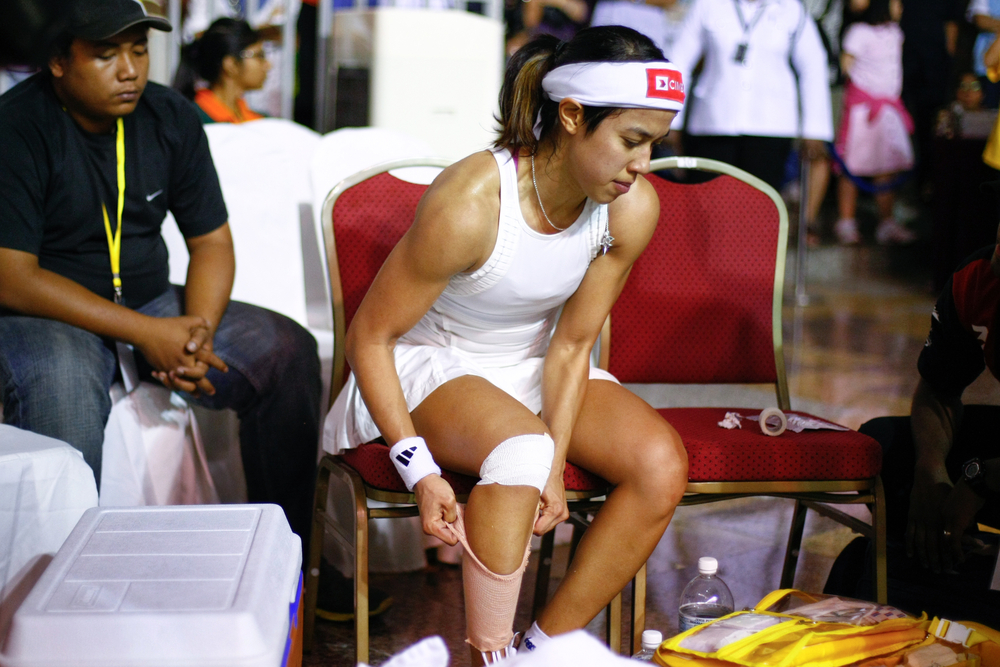
Heat Exhaustion Is A Risk In Squash
Squash is a high-tempo game, and even at beginner levels, the physical exertion can cause heat stress and dehydration to stop a game or even cause a player to collapse with exhaustion.
Many squash centers have central climate control to ensure that the players do not overheat, but this is not always possible as hot weather conditions and humidity will still have an impact.
If you are playing in warm weather or high humidity, it is imperative that you stop and rest during points or games or take liquid on board as and when you need it to prevent dehydration and fatigue from setting in.
One of the primary causes of muscle cramps in sports is inadequate hydration or poor liquid replenishment during extreme exertion. This can quickly happen in squash, so bring good sports to drink to replace electrolytes lost during play.
Cardiac Related Injuries In Squash
The last type of injury that can be far more dangerous than the ones listed above is cardiac arrest or heart attack, which are more common than you might think. While not as common as the impact and muscle-strain type injuries, heart attacks, and related events can occur due to the high-energy nature of squash.
There is a lot of running, sprinting, and swinging, and these actions significantly increase the heart rate and blood pressure. This can also occur with the ‘weekend warrior’ syndrome, where people who aren’t fit try to play the game for the first time and put a severe strain on their hearts which are mainly used to sitting on the couch!
If you are genetically predisposed to cardiac disease like high blood pressure or have had cardiac issues in the past, it would be wise to get yourself checked and stress-tested before you play to see if your heart can cope with the workload you will be putting under when playing squash.
If you have a history of heart disease in your family or suspect you may be at risk, perhaps you should take up a less strenuous sport until you have been cleared to play by your doctor.
Suppose you are playing and you find yourself with any symptoms of cardiac distress like shortness of breath, pressure in the chest, or dizziness. In that case, you need to stop immediately, and if those symptoms persist, get help or get to an emergency room.
Conclusion
From the injury lists above, it seems that squash poses a high risk for various injuries to players. Still, considering the number of people that play this game around the world daily and the relatively few injuries that occur, squash is not as dangerous as it appears and, when played with a good level of fitness and the right equipment, is quite enjoyable and is also a great workout!
Still, it’s better to be aware of the risks before you take up the sport and even better to get some professional coaching or play with people that know the game and can give you sound advice on technique, court position, and equipment, so you run less of risk of picking up a common squash injury.

